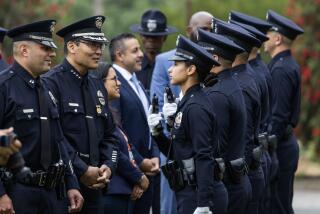Police Officials Back Plan for Civilian Posts : Law enforcement: 10 specialists would be hired to take evidence at crime scenes, freeing sworn officers for more pressing tasks.
In the first step toward having civilians take positions in the San Diego Police Department that have traditionally been handled by sworn officers, the agencyâs second-in-command has recommended that 10 specialists be hired to take evidence at crime scenes.
The concept of âcivilianizingâ is relatively simple: replacing highly skilled, and, in some cases, high-priced, police officers with lower-paid civilians in tasks that would free the police to handle more pressing matters.
The department already has 48 so-called âcommunity service officers,â whose duties range from conducting Neighborhood Watch meetings to handling complaints from city residents.
But the suggestion by Norm Stamper, executive assistant police chief, that non-sworn employees be permitted to take fingerprints and photographs, conduct interviews and prepare reports, just as officers do now, might be the first step in identifying many other positions for civilians.
Stamper also has recommended putting a civilian in as head of the communications unit, now a captain. The director of that division supervises all radio dispatchers.
âThe more positions we can convert to civilians, the more police officers we can put on the street,â he said. âThatâs always been my position.â
With no money for the new jobs, Stamper said it may be at least a year before the civilian jobs are worked into the budget. But the departmentâs executive management team, led by police Chief Bob Burgreen, has approved of the concept.
Stamper is patterning his initial proposal after a similar program in National City, where six âcrime scene specialistsâ take over from officers after they arrive at a âcold-crimeâ location where the suspect has long fled.
Sometimes, the concept works exactly as designed.
On her first day on the job as a specialist in National City, Norma Valverde responded with two officers to a call of an armed robbery at a house.
While she began collecting evidence, the officers hit the street. One of the suspects was arrested three blocks away as he was about to enter a taxicab. The other officer arrested a suspect in the robbery of a nearby doughnut shop.
Valverde, who now works in the crime lab of the San Diego Police Department, is eager for the chance to repeat her crime scene work in San Diego.
âYou arrive at the scene where people are distraught,â she said. âYou get the feeling youâre helping someone. I hope we can get it going.â
The notion of adding civilians to any police force is a touchy one. Police unions typically fight any attempt to replace sworn officers with non-sworn employees. But they also welcome the addition of such hires to allow officers to tend to more important duties.
âThere isnât anything you canât civilianize,â said Harry O. Eastus, president of the San Diego Police Officers Assn. âBut youâve got to figure out if youâve got the right experience in some of these jobs if you put civilians in.â
Eastus said the police union probably would not oppose Stamperâs plan to add 10 crime scene specialists but might have objections to his idea of replacing the communications captain.
âTo free our officers up is one thing,â he said. âBut to actually lose jobs, we have some concerns over that.â
Santa Ana police officers in Orange County complained bitterly in the early 1980s when then-Chief Ray Davis converted dozens of jobs typically held by officers into civilian posts.
At the time, Davis said he could pay the salaries of two civilians for the amount he was spending on one officer.
Today, 43 civilian employees out of a force of 407 work in a variety of assignments, such as crime prevention, community relations, collecting evidence at crime scenes and investigating traffic accidents.
âWeâve found the program to be extremely successful,â said Santa Ana police Lt. Robert Helton, a department spokesman. âIn the beginning, there was that fear of officers losing their positions. But itâs worked out well.â
One prevailing argument against hiring more civilians is that they might take jobs that could be filled by injured officers or those placed on administrative duty because of internal affairs investigations or other reasons.
But critics of police agencies say they are typically filled with fully trained officers with years of experience who are doing nothing more than answering telephones and filling out reports.
A San Diego police recruit is paid $27,492 a year. Once they graduate from the academy, they are paid $33,876, and the most an officer can earn before being promoted is $43,272 a year. By contrast, the most a beginning community service officer can earn is $26,052.
âItâs reasonable to ask about why some positions are held down by police officers,â Stamper said. âBut the arguments to civilization always prevail. Iâve lost a lot of debates over it.â
More to Read
Sign up for Essential California
The most important California stories and recommendations in your inbox every morning.
You may occasionally receive promotional content from the Los Angeles Times.










